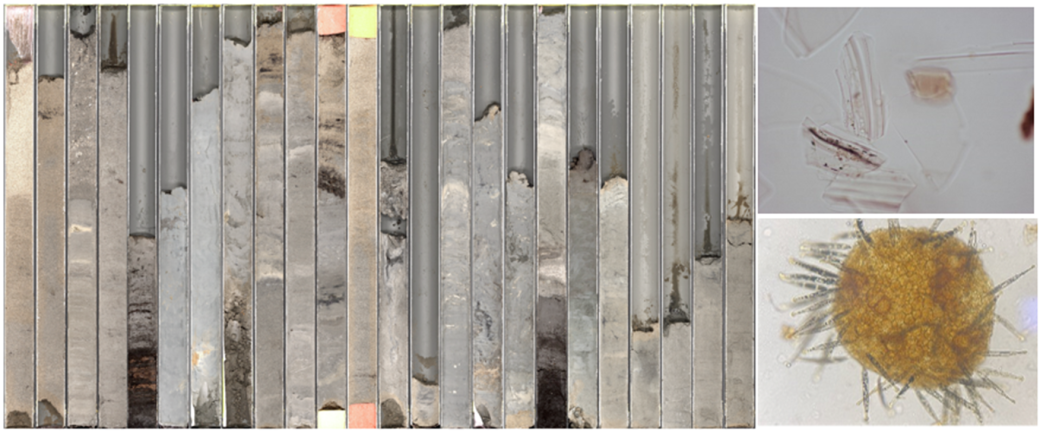
Lead supervisor: Christine Lane, Geography
Co-supervisor: Matthew Adeleye, Geography; Natasha Barlow and Amy McGuire, School of Earth and Environment, University of Leeds
Brief summary:
Build the first tephrostratigraphy for the North Sea region, to date sea-level rise and vegetation change during the Last Interglacial.
Importance of the area of research concerned:
Models of future climate change are, for the most part, informed by observational data spanning the last c.150 years – a period that has seen only limited climatic variability. To test our long-term projections of earth system responses therefore, we exploit the geological record. Previous climatically warm periods, e.g. the Last Interglacial (LIG; 130-116 ka), provide natural laboratories to study landscape and ecosystem responses to warmer-than-present conditions.
A range of proxy-based approaches, e.g. pollen, sedimentology, have been used to reconstruct LIG environmental conditions across NW Europe. A key challenge however, is building age models that can describe the timing and rates of change described in the proxy records. Volcanic ash (tephra) layers, traceable often over many 1000s of kilometres from their source, provide isochrons for precise synchronisation of terrestrial, marine and ice core records. Tephrochronology has become a staple method for dating and correlating European Holocene and Last Glacial -age sequences, however its application in LIG sequences remains limited.
Project summary :
The project will improve our understanding of the nature, timing and propagation of environmental change in the North Sea region, e.g. vegetation development and sea-level rise, under warmer-than-present LIG climate conditions. Traditionally, terrestrial LIG sequences have been dated through correlation of pollen stratigraphies to regional stratotypes and few directly dated (Turner, 2000). The development of a regional tephrostratigraphic framework will tie together, and allow precise comparison of, key LIG sedimentary records. The work will extend the existing LIG tephrostratigraphy for the North Atlantic (Abbott et al., 2013).
This a collaboration between the Universities of Leeds, Cambridge, Utrecht and the Dutch Geological Survey (TNO), and will build upon the RISeR project (riser.leeds.ac.uk), which seeks to constrain the rate of sea-level change, in the North Sea, during the LIG.
What will the student do?:
The student will detect, chemically characterise and correlate far-travelled tephra layers within sediment records from sites across the North Sea basin, British Isles, and the Netherlands. Lab-based cryptotephra methods will be used to find far-travelled and low concentration cryptotephra layers, not visible to the naked eye.
Study sites will be selected in collaboration with partners on the RISeR project (PI & external supervisor, Natasha Barlow) and sampling will involve visits to other labs in the UK (e.g., Leeds) and The Netherlands (e.g., TNO, Utrecht), where LIG sediments are currently under research. There is potential for incorporating fieldwork to access further LIG sequences in the British Isles and the opportunity to carry out pollen analysis on new or archive samples to reconstruct vegetation dynamics during the LIG.
Data compilation and interpretation will involve developing improved age-depth models for important LIG sequences. Comparison of palaeoenvironmental proxy datasets, including vegetation and past sea-level change, within a unified chronology will establish the nature and rates of LIG environmental change both at individual sites and on a regional scale.
References - references should provide further reading about the project:
Abbott, P.M., Austin, W.E., Davies, S.M., Pearce, N.J. and Hibbert, F.D., 2013. Cryptotephrochronology of the Eemian and the last interglacial–glacial transition in the North East Atlantic. Journal of Quaternary Science, 28(5), pp.501-514.
Cohen, K.M., Cartelle, V., Barnett, R., Busschers, F.S. and Barlow, N.L., 2022. Last Interglacial sea-level data points from Northwest Europe. Earth System Science Data, 14(6), pp.2895-2937.
Turner, C., 2000. The Eemian interglacial in north European plain and adjacent areas. Geologie en Mijnbouw, 79(2/3), pp.217-232.
Applying
You can find out about applying for this project on the Department of Geography page.